How to grow tulips by March 8
Tulips are considered a symbol of femininity and remind of the coming of spring. They abound in store shelves on March 8. By tradition, it is these flowers that men give the fair sex on International Women's Day.
In most of the territory of our country in early spring, it is too cold outside for growing everyone's favorite flowers. For the holidays, they are bred in greenhouse conditions. This is a profitable seasonal business - all grown plants are sold out in just 1-2 days. The cultivation of flowers for sale requires knowledge of the technology of forcing tulips by March 8 in a greenhouse. Without this, it will not be possible to get the formed buds by the desired day.
The content of the article
Suitable Tulip Varieties for Greenhouse Growing
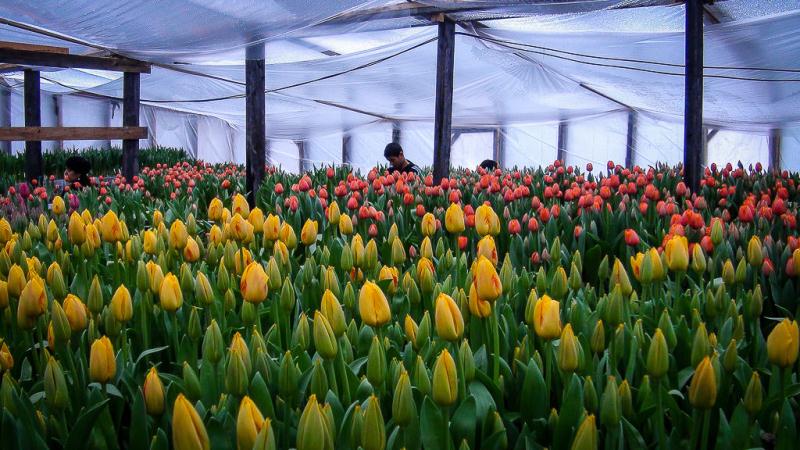
Before you start growing tulips in a greenhouse, it is worth choosing the varieties that are best suited for this purpose:
- Maureen... It has classic-shaped buds with a height of 8-10 cm and a diameter of 10-12 cm. Their main color is white and only at the base it turns into cream. The stems are straight and thick, reaching 50 cm.
- Keys Nelis. It has large, classic-shaped buds. Their height varies between 10-12 cm, and the diameter is 11-14 cm. The buds do not open until the end during flowering. The lower part is painted in hot pink, and the edges have a rich yellow tint. Stems are thick, straight, up to 60 cm. The foliage has a reddish tint.
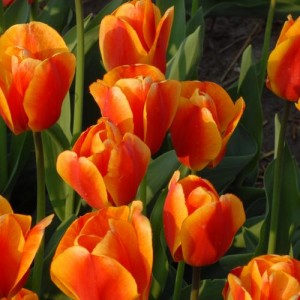
- Oxford. The goblet buds have a diameter of 8-10 cm. The petals are bright red. Inside, the base has a yellow-green tint. The variety is immune to viral diseases.
- Vivex. The bud has an elongated goblet shape. Does not unfold in the sun, remaining graceful until fading. Rich coral, pale red-orange hues and pink stripes are combined on each petal. The flower base is yellow.
- Eric Hofsue... Large heavy buds have a goblet shape. The flowers do not open under the influence of the sun. Crimson petals with cream edges. Strong stems reach a height of 75 cm.
- Parade record. Large goblet petals of bright red color. The base of the buds is yellow with black blotches. The stem is strong and tall.
- Aristocrat. Large buds have a goblet shape. The flowers are light blue, gradually flowing into white.
Selection and receipt of planting material
In order for all tulips to sprout, give beautiful buds and not get sick during the growing process, it is important to choose the right planting material. The flowers are grown from bulbs purchased from gardening shops, nurseries, markets, or grown independently.
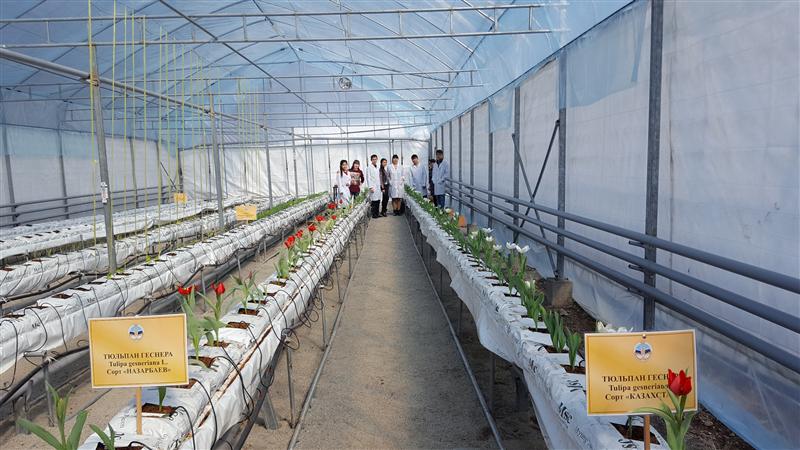
When choosing tulip bulbs, it is important to pay attention to the following parameters:
- Scales. The casing should not be too dark brown and elastic. A hard and dark brown shell is a sign that the bulbs have been overexposed in the soil.
- The size. The optimum diameter of the bulb varies within 3-4 cm. It is possible to purchase smaller specimens, but they take longer to germinate.
- Appearance... The planting material must have the correct shape, uniform color and be perfectly smooth, without mold, stains, damage and other signs of disease.
- Stem. Small in size, without mold or stains. Only the tip sticks out of the bulb.
- Weight and density.A high-quality bulb is dense to the touch. When pressed, no juice should be released from it. If the planting material is suspiciously light, then it is rotten inside.
- Bottom part. The bottom is dense, with tubercles, from which roots will appear.
The optimal time to buy tulip bulbs is from early July to late September. At this time, it will be possible to purchase high-quality planting material.
It is easy to get yourself from plants grown in season in the open field. There are several nuances to consider:
- So that the planting material is saturated with useful trace elements and turns out to be of high quality, after the buds open, they are cut off. This happens 3-4 days after the tulip blooms.
- You cannot cut off unopened buds. This negatively affects the development of greens and bulbs.
- The planting material is dug up when the greens and the stem turn yellow by about a third. This happens in late June or early July.
After collection, the planting material is sorted by size. Large specimens are laid in one direction, small ones in the other.
Important! Only round bulbs are suitable for forcing.
For the first month, planting material is stored at a temperature of + 20 ° C. Then this indicator is lowered to + 17 ° C.
The bulbs are stacked in boxes or on pallets with a mesh day. The humidity in the room for the formation of a developed root system is 70-75%.
Planting tulips by March 8
Planting tulips is the most important step in flower cultivation by 8 March. It depends on how correctly the bulbs are planted whether the plants will give buds by the required time.
Calculation of landing dates
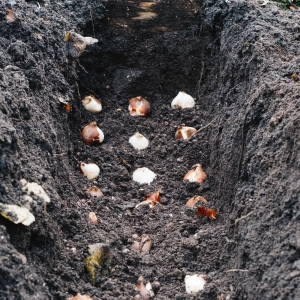 When determining the timing of landing, the following factors are taken into account:
When determining the timing of landing, the following factors are taken into account:
- Room temperature. In order to quickly grow tulips and make them bloom by March 8, it is important to create the right temperature readings at certain times.
- Bulb rooting time. This period takes 4 to 8 weeks.
- Timing from planting to flowering. Varies within 16-20 weeks.
- Tulip variety... The duration of cultivation varies depending on the variety.
To simplify the calculations, use the following formula: from March 7 (the time of collecting flowers) 3-4 weeks (period of germination of bulbs) and 16-18 weeks (period from germination to flowering) are taken. To get flowers by March 8, they are planted from December 26 to November 7.
Preparing the greenhouse and soil for forcing tulips
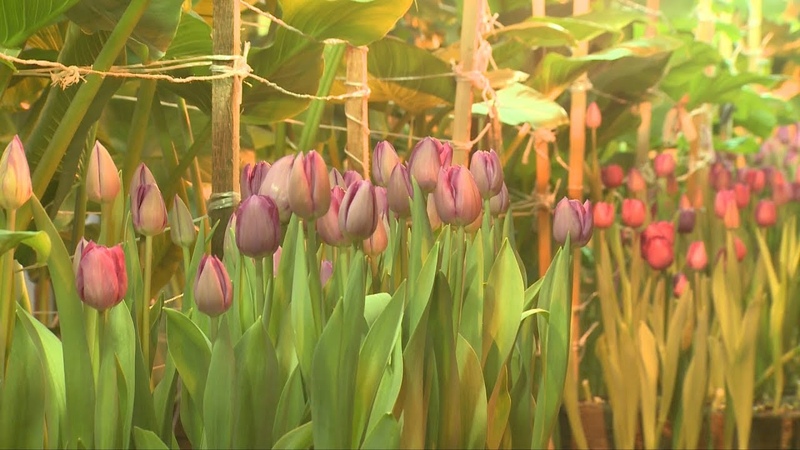
Before planting tulips, you need to prepare the soil. Otherwise, the plants will get sick.
The soil should be light and water permeable. For its manufacture, sand and sawdust are mixed in equal proportions. Drainage must be used: chipped brick, expanded clay, fine gravel, shell rock.
To disinfect the soil, it is calcined in the oven at maximum temperature for ¼ hour. When the soil has cooled, it is watered with a dark pink solution of potassium permanganate or "Fitosporin". Drainage is treated in the same way.
The bulbs are planted in wide boxes 15 cm deep. They are disinfected by soaking in a dark pink solution of potassium permanganate or pouring boiling water over them.
The greenhouse is fumigated with sulfur, and the walls are wiped with a solution of copper sulfate - 1 tbsp. l. 10 liters of water.
For forcing tulips, you will need special equipment. It is imperative to use phytolamps and heating devices - without them it will not be possible to create the necessary conditions.
Preparation of planting material
It is important to prepare the planting material before planting:
- Calibration. Before planting, the bulbs are sorted out and checked for stains and damage. Smaller specimens germinate later, so they are planted several days later than larger ones.
- Cooling. To make the bulbs germinate faster, they are placed for 2 weeks in a room with a temperature of + 9 ° C.
- Cleaning. The bulbs are peeled from brown husks. To ensure the quality of the planting material and to speed up its germination, the bulbs are checked for damage, mold and stains.
- Disinfection. The planting material is soaked for 40 minutes. in a dark pink solution of potassium permanganate or celandine broth.
Step-by-step landing instructions for beginners
Tulips tolerate a thickened planting well. The bulbs are stirred close to each other. For 1 m² - up to 300 plants.
The bulbs are planted in the ground with the bottom down. They are buried 3-4 cm and covered with sand. Then they are poured abundantly with water at room temperature. If the bulbs become bare, they are again covered with soil.
Growing technology and care
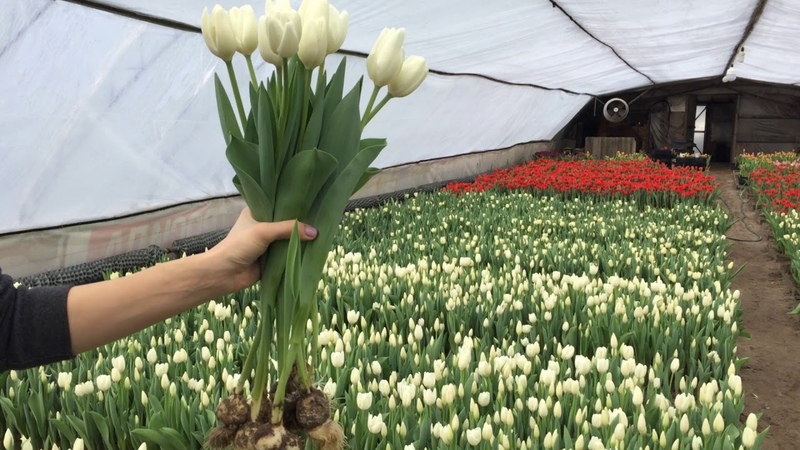
In order to sell tulips when they are in high demand, it is important to provide them with proper care. Forcing in a greenhouse by a certain date has its own subtleties and nuances.
Lighting
The greenhouse is shaded for the first 2 months, as the planted bulbs must be kept in the dark. Until February, tulips have enough natural light. Then the plantings are provided with 12 hours of daylight.
Temperature
The first 2 months after planting in the greenhouse maintain a temperature of + 7 ... + 9 ° C. Then the temperature is increased to + 18 ... + 17 ° С during the day and + 14 ... + 15 ° С at night. When tulips bloom, the temperature is lowered to + 15 ° C.
Humidity
Tulips love high humidity. To provide them with optimal conditions, the walls of the greenhouse are sprayed daily.
Watering
Every morning the plants are watered with water at a temperature of + 8 ... + 12 ° С.
Top dressing

The first 2 weeks watering is alternated with feeding 20 g of calcium nitrate, diluted in 10 liters of water. During the entire growing period, tulips are fed twice with special fertilizers for bulbous plants, diluted according to the instructions.
Useful tips and possible difficulties
When growing tulips, problems can arise:
- The buds are dry, feel like paper, or the petals are too thin. The reason is poor air exchange or too high temperature. To remedy the situation, ventilate the greenhouse and lower the temperature in it.
- Dropped buds. This is a sign of a high temperature in the greenhouse. Cooling the room will help save the plant.
- Peduncles are weak. This happens if the tulips lack calcium or the night temperature is higher than the daytime. With a similar problem, plants are fed with 0.2% calcium sulfate, the temperature is normalized.
- The bulbs do not take root. This happens when the room humidity is low. If the problem remains relevant with daily spraying of greenhouse walls, then a humidifier will have to be installed in the room.
- Rotting bulbs. The problem lies in the elevated soil temperature. This happens if tulips are watered with insufficient cold water.
- Greenery grows, but peduncles do not appear. This happens if the planting material was too small.
The flowering of tulips will be accelerated by watering with water at room temperature (+ 20 ° C). This is done 3 days before the buds appear.
It is important that no water gets on the tulip leaves and buds. They are watered at the root. Moisture in greenery will cause plant disease.
Note! Most growing problems arise when the temperature regime is not observed. It is very important that the temperature indicators of the room and water correspond to the norm.
Correct harvest
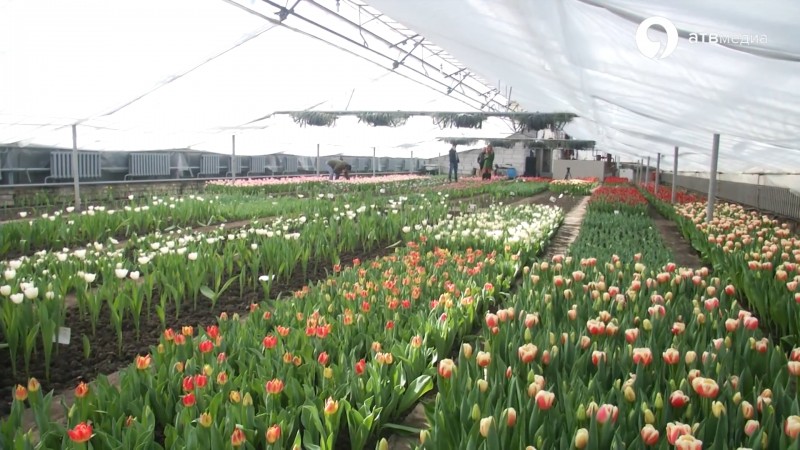
How well the buds are cut depends on how long they will stay fresh and whether the bulbs will be suitable for planting next year.
There are three harvesting options:
- Cut tulips as low as possible with leavesand. Do this if you do not plan to use the bulbs for planting next season. Since in this case a sufficient amount of microelements will not enter the planting material and the chances that it will germinate are reduced.
- Cut tulips so that the ground part with a height of at least 7-10 cm remains in the ground. In this case, the flower will have a shorter stem, but enough greenery will remain so that the bulbs are saturated with useful substances. This will make them suitable for planting next year.
- Dig up with the bulbs. Then the bulbs on the tulips are washed clean from the ground and sold as they are. These flowers will stay fresh for much longer.
It is interesting:
Growing petunias at home and in the open field: necessary conditions, planting, care.
Conclusion
Growing tulips in a greenhouse requires special equipment and constant attention from the owner of the plantings. In case of violation of the temperature regime, insufficient humidity or improper watering, the plants will get sick and will not bloom.
Despite all the difficulties, even a novice gardener will cope with growing tulips by March 8. The main thing is to follow the planting and care instructions.